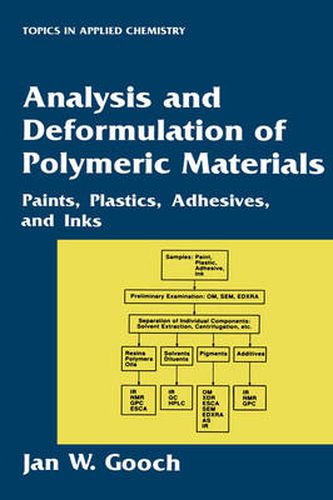Readings Newsletter
Become a Readings Member to make your shopping experience even easier.
Sign in or sign up for free!
You’re not far away from qualifying for FREE standard shipping within Australia
You’ve qualified for FREE standard shipping within Australia
The cart is loading…






This title is printed to order. This book may have been self-published. If so, we cannot guarantee the quality of the content. In the main most books will have gone through the editing process however some may not. We therefore suggest that you be aware of this before ordering this book. If in doubt check either the author or publisher’s details as we are unable to accept any returns unless they are faulty. Please contact us if you have any questions.
This book is designed for the chemist, formulator, student, teacher, forensic scientist, or others who wish to investigate the composition of polymeric materials. Theinformationwithinthesepagesisintendedtoarmthereaderwiththenecessary workingknowledgetoanalyze,characterize, anddeformulatematerials. ThestructureoftheContentsisintendedtoassistthereaderinquicklylocating the subject of interest and proceed to it with a minimum of expended time and effort. The Contents provides an outline of major topics and relevant materials char- terizedforthereader'sconvenience. Anintroductiontoanalysisanddeformulation is provided in Chapter 1 to acquaint the reader with analytical methods and their applications. Extensive references are provided as additional sources ofinfor- tion. All tables arelocatedin theAppendix, beginning onp. 235. GUIDE FOR USE This is a practical book structured to efficiently use the reader’s time with a minimum effort of searching for entries and information by following these brief instructions: 1. Searchthe Contents and/orIndex fora subject withinthe text. 2. Analysis/deformulation principles are discussed at the outset to familiarize the reader with analysis methods and instruments; followed by formu- tions, materials, and analysis ofpaint, plastics, adhesives, and inks; and finally reformulation methods to test the results of analysis. 3. Materials and a wide assortment of formulations are discussed within the text by chapter/section number. 4. Materials are referred toby various names (trivial, trade, and scientific), and these are listed in tables and cross-referenced to aid the reader.
$9.00 standard shipping within Australia
FREE standard shipping within Australia for orders over $100.00
Express & International shipping calculated at checkout
This title is printed to order. This book may have been self-published. If so, we cannot guarantee the quality of the content. In the main most books will have gone through the editing process however some may not. We therefore suggest that you be aware of this before ordering this book. If in doubt check either the author or publisher’s details as we are unable to accept any returns unless they are faulty. Please contact us if you have any questions.
This book is designed for the chemist, formulator, student, teacher, forensic scientist, or others who wish to investigate the composition of polymeric materials. Theinformationwithinthesepagesisintendedtoarmthereaderwiththenecessary workingknowledgetoanalyze,characterize, anddeformulatematerials. ThestructureoftheContentsisintendedtoassistthereaderinquicklylocating the subject of interest and proceed to it with a minimum of expended time and effort. The Contents provides an outline of major topics and relevant materials char- terizedforthereader'sconvenience. Anintroductiontoanalysisanddeformulation is provided in Chapter 1 to acquaint the reader with analytical methods and their applications. Extensive references are provided as additional sources ofinfor- tion. All tables arelocatedin theAppendix, beginning onp. 235. GUIDE FOR USE This is a practical book structured to efficiently use the reader’s time with a minimum effort of searching for entries and information by following these brief instructions: 1. Searchthe Contents and/orIndex fora subject withinthe text. 2. Analysis/deformulation principles are discussed at the outset to familiarize the reader with analysis methods and instruments; followed by formu- tions, materials, and analysis ofpaint, plastics, adhesives, and inks; and finally reformulation methods to test the results of analysis. 3. Materials and a wide assortment of formulations are discussed within the text by chapter/section number. 4. Materials are referred toby various names (trivial, trade, and scientific), and these are listed in tables and cross-referenced to aid the reader.